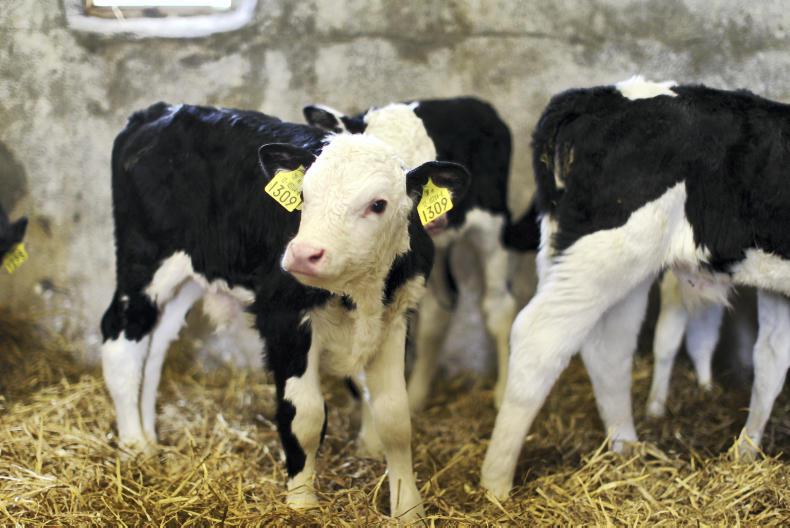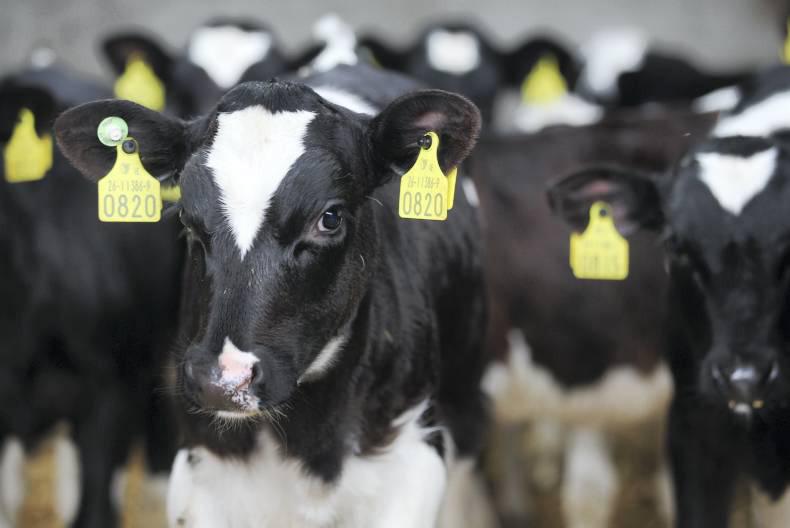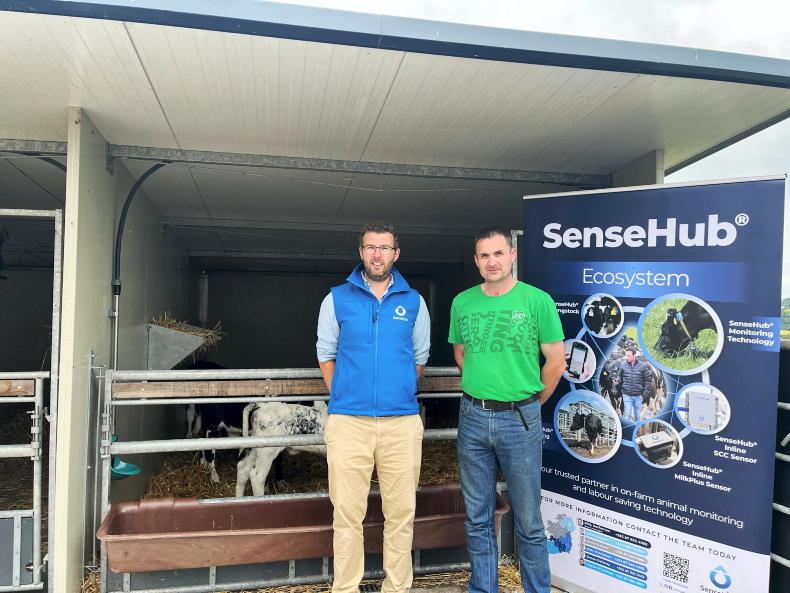At this stage, over 75% of the calves have landed on spring-calving dairy farms across Ireland – maybe a few less the further north you travel up the country. Rearing healthy calves with minimum mortality is crucial in a successful dairy business. Good calf-rearing systems should target less than 3% mortality from calving to weaning.
We all know that giving the newborn calf enough good-quality colostrum is critically important to ensure its health and well-being. Approximately two-thirds of tests carried out in national vet laboratories show inadequate absorption of antibodies is a major factor in calf death and disease in Ireland.
One interesting piece of research from some calf care trials recently showed a drop-off in biestings quality for those cows calving in late March-April. Why?
Month of calving
Cows that calved in April produced colostrum of a lower quality than cows calving in the earlier spring months or in the autumn months. In general, the cows that calved in April had a longer dry period than cows calved earlier. The reasoning seemingly is that cows with long dry periods are predisposed to becoming excessively fat, which may have negative consequences on the cow’s immune system and she may produce colostrum with less antibodies (IgG) as a result. So the key message here is don’t let late-calvers get too fat – not alone does it reduce biestings quality, but it predisposes the cow to all sorts of metabolic problems.
Role of transition milk
Milk collected after the first milking is referred to as transition milk. Research has shown newborn calves can’t absorb Immunoglobulin G (IgG) from colostrum after 24 hours of age. Nonetheless, transition milk (milkings two to six post-calving) fed over the first three days of the calf’s life can have beneficial effects as it contains higher levels of antibodies than whole milk and this has previously been shown to reduce the incidence of calf scour. A study carried out at Teagasc Moorepark found that when four feeds of transition milk were fed after the initial feed of colostrum, it reduced the number of droopy ears and streaming eyes; so calf health was improved.
How much milk do calves need?
Suckler calves have access to an ad-lib supply of milk and drink up to 20% of their birth bodyweight (8l for 40kg calf) daily which allows them to put on approximately 1kg per day. Traditionally calves from the dairy herd have been fed two litres of milk in the morning and two litres in the evening.
Feeding two litres in the morning and two litres in the evening seriously limits the calf’s growth potential and increases the risk of it developing disease
The problem is that this is only about 8% to 10% of their birth bodyweight and only provides enough energy to maintain the calf until they start eating concentrate at three to four weeks of age and get additional energy for growth from that. Feeding two litres in the morning and two litres in the evening seriously limits the calf’s growth potential and increases the risk of it developing disease.
Research
Recent research worldwide has shown that providing greater amounts of milk to calves in the pre-weaning period can result in better growth rates and lower disease and mortality in the pre-weaning period, in addition to greater milk production and fertility in later life.
Teagasc Moorepark carried out a trial which compared feeding calves 10% (4l for a 40kg calf) or 15% (6l for a 40kg calf) of their birth body weight in milk. The weight gain of the calves fed 15% of their birth bodyweight in milk was higher during the pre-weaning period than calves fed 10% of their birth bodyweight in milk. As they were weaned based on weight (approximately 100kg for a Holstein Friesian calf) it took fewer days for them to achieve their weaning target weight. Many farmers may be fearful of more scouring calves when feeding additional milk, but there was no evidence of this in the Moorepark study.
Only the first milking (colostrum) from freshly calved cows is suitable as a feed for newborn calves. April-calvers generally have lower-quality colostrum. Don’t let them get too fat.Maximise colostrum quality by milking the cow as soon as possible after calving.Feeding transition milk (milkings two to six post-calving) after the initial first feed of colostrum during the first three days of life can improve calf health.Feed calves 13% to 15% of their birth bodyweight in milk (6l for a 40kg calf) from day three to weaning. Read more
Vet's corner: rearing dairy calves
When to start calving in the east
At this stage, over 75% of the calves have landed on spring-calving dairy farms across Ireland – maybe a few less the further north you travel up the country. Rearing healthy calves with minimum mortality is crucial in a successful dairy business. Good calf-rearing systems should target less than 3% mortality from calving to weaning.
We all know that giving the newborn calf enough good-quality colostrum is critically important to ensure its health and well-being. Approximately two-thirds of tests carried out in national vet laboratories show inadequate absorption of antibodies is a major factor in calf death and disease in Ireland.
One interesting piece of research from some calf care trials recently showed a drop-off in biestings quality for those cows calving in late March-April. Why?
Month of calving
Cows that calved in April produced colostrum of a lower quality than cows calving in the earlier spring months or in the autumn months. In general, the cows that calved in April had a longer dry period than cows calved earlier. The reasoning seemingly is that cows with long dry periods are predisposed to becoming excessively fat, which may have negative consequences on the cow’s immune system and she may produce colostrum with less antibodies (IgG) as a result. So the key message here is don’t let late-calvers get too fat – not alone does it reduce biestings quality, but it predisposes the cow to all sorts of metabolic problems.
Role of transition milk
Milk collected after the first milking is referred to as transition milk. Research has shown newborn calves can’t absorb Immunoglobulin G (IgG) from colostrum after 24 hours of age. Nonetheless, transition milk (milkings two to six post-calving) fed over the first three days of the calf’s life can have beneficial effects as it contains higher levels of antibodies than whole milk and this has previously been shown to reduce the incidence of calf scour. A study carried out at Teagasc Moorepark found that when four feeds of transition milk were fed after the initial feed of colostrum, it reduced the number of droopy ears and streaming eyes; so calf health was improved.
How much milk do calves need?
Suckler calves have access to an ad-lib supply of milk and drink up to 20% of their birth bodyweight (8l for 40kg calf) daily which allows them to put on approximately 1kg per day. Traditionally calves from the dairy herd have been fed two litres of milk in the morning and two litres in the evening.
Feeding two litres in the morning and two litres in the evening seriously limits the calf’s growth potential and increases the risk of it developing disease
The problem is that this is only about 8% to 10% of their birth bodyweight and only provides enough energy to maintain the calf until they start eating concentrate at three to four weeks of age and get additional energy for growth from that. Feeding two litres in the morning and two litres in the evening seriously limits the calf’s growth potential and increases the risk of it developing disease.
Research
Recent research worldwide has shown that providing greater amounts of milk to calves in the pre-weaning period can result in better growth rates and lower disease and mortality in the pre-weaning period, in addition to greater milk production and fertility in later life.
Teagasc Moorepark carried out a trial which compared feeding calves 10% (4l for a 40kg calf) or 15% (6l for a 40kg calf) of their birth body weight in milk. The weight gain of the calves fed 15% of their birth bodyweight in milk was higher during the pre-weaning period than calves fed 10% of their birth bodyweight in milk. As they were weaned based on weight (approximately 100kg for a Holstein Friesian calf) it took fewer days for them to achieve their weaning target weight. Many farmers may be fearful of more scouring calves when feeding additional milk, but there was no evidence of this in the Moorepark study.
Only the first milking (colostrum) from freshly calved cows is suitable as a feed for newborn calves. April-calvers generally have lower-quality colostrum. Don’t let them get too fat.Maximise colostrum quality by milking the cow as soon as possible after calving.Feeding transition milk (milkings two to six post-calving) after the initial first feed of colostrum during the first three days of life can improve calf health.Feed calves 13% to 15% of their birth bodyweight in milk (6l for a 40kg calf) from day three to weaning. Read more
Vet's corner: rearing dairy calves
When to start calving in the east










SHARING OPTIONS